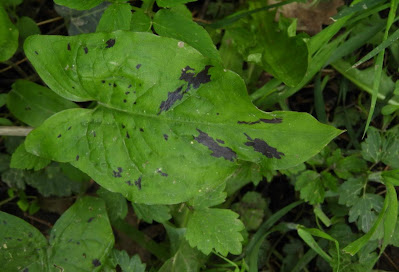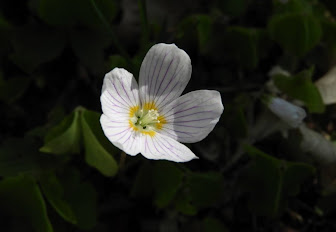The UK is home to about half of the world's bluebell population and in a Plantlife survey was voted people's favourite flower in England (and the UK as a whole although the Primrose came first in Wales, Northern Ireland and Scotland.) It suggests water to many writers and Gerard Manley Hopkins wrote in his journal of "falls of sky-colour washing the brows and slacks of the ground with vein blue."

Hyacinthoides non-scripta has undergone a number of name changes. Linnaeus placed it in the genus Hyacinthus. In the early nineteenth century it was classified in the Scilla genus and known as Scilla nutans or nodding squills. The nodding description is appropriate. Then in the mid-nineteenth century it was reclassified it under the label Endymion non-scriptus. In one version of the Greek myth Endymion was a youth who was put into an eternal sleep by Zeus. The link between the bluebell and Endymion isn't entirely clear but herbalists once said bluebells prevented nightmares..... But the fresh bluebell is poisonous: be warned!
The gummy sap from the bulb was used as a starchy glue in bookbinding. It was so toxic it prevented certain insects attacking the binding. It was also used to stiffen Elizabethan ruffs and for attaching feathers (fletchings) to arrow shafts.
The name Linnaeus chose for the genus refers to the myth of Hyacinthus a young man beloved by both Apollo and Zephyrus. He was killed by a discus thrown by Apollo which was blown off course by Zephyrus. Apollo, devastated by the death, swore to make him immortal by turning him into a delicate blue flower. The plant sprang up from his blood and Apollo inscribed it 'Ai, Ai' meaning 'alas' to express his grief. The botanical name Hyacinthoides non-scripta refers to the UK bluebells as having no inscription. I expect it will change again now I've learnt to spell it without checking!
While on the subject of myth there are many associations between fairies and bluebells. Once upon a time fairies were mysterious, unpredictable and rarely benevolent. Bluebell perfume was believed to bring a human under fairy influence. Fairies rang bluebells to announce their gatherings. If a person heard the rings it was a warning of death coming soon. Humans would ring these bells at their peril to summon the fairies. In the eighteenth century fairies began to lose this malevolent reputation and gradually became the subject of children's story books.
The greatest impact of the bluebell could be argued to be the sight of it spreading in the woods; the "darkest, lushest blue-bell bed" which Keats used as an image in his poem Endymion. The same work opens with the line"A thing of beauty is a joy forever:". Keats knew a thing or two....
However, to start looking at the botanical detail....
The flower spike of Hyacinthoides non-scripta is one-sided and droops at the tip. The flowers with individual stalks hang downwards and each is made of six tepals. There are pairs of narrow linear-lanceolate blue bracts peeling away from where the flower stalk meets the main stem. The lower bract is larger than the upper. I find these bracts particularly graceful.
There can be as many as twenty bells on one inflorescence.
There are three inner and three outer tepals which form a parallel-sided tube. They curve back strongly at their ends (giving rise to some of the folk names eg Crake-feet ie crows' feet). Six stamens bear white or cream pollen and there is a honey-like scent. The perfume which attracts pollinators into the woods is said to have 35 components. The curved stems may be suffused with blue, masking the chlorophyll.
These are the ID points that identify the English (UK) Bluebell rather than the H.x massartiana which is the cross between between naturalised H. hispanica and H. non-scripta. It is this one found most commonly naturalised. Any of the following characteristics indicate some degree of hybridisation: upright stems, no scent, conical bell shaped flowers with open tips, blue pollen. It is a threat to the native plant.
The leaves of the English Bluebell are narrow. There are no stem leaves, only basal; they are strap-shaped, long, keeled and narrow. They taper slightly over their length but abruptly at the end. One here has pierced and carried aloft one of last autumn's leaves. I always like to see this.
Although bluebells are associated with ancient woodland where their growth is largely undisturbed and they can take advantage of the light before the leaf canopy grows, they can also be found in open areas, hedgerows and meadows. Experts now think that any decline of bluebells is more to do with trampling of the leaves (which are then unable to feed the bulbs) than removal of blooms, the seeds which would otherwise fall to the ground in autumn to be buried in leaf litter. Picking is now, however, discouraged. It takes five years for a seed to mature into a bulb capable of producing flowers.
Habitat destruction can also be a threat. Botanists believe the native bluebell may be most under threat from vigorous H. x massartiana the hybrid of the English and the naturalised Spanish one, Hyacinthoides hispanica, introduced to gardens by 1683. The Hybrid Bluebell is fertile and able to form a complete range of intermediates. Small populations such as those in my garden have hybridised. I have only found the true native in the Wye valley woods. Research continues.
Gillian Clarke, who was National Poet of Wales between 2008 -2016, and who always gives generously of her time to students and readers, has granted permission for me to quote from her poem 'Bluebells'. I can't think of a better way to draw this celebration of bluebells to a close.
Which came first? Scent or heartburst of blues?
Cerulean, indigo, sky, a breath of rain,
sunlight between stems of sessile oaks
before the wood breaks leaf, when trees first feel
a quickening in their roots -the shift and stir
of bulbs swelling beneath the earth.
Acknowledgements
Mabey Flora Britannica
Fiona Stafford The Brief Life of Flowers
Simon Harrap's Wild Flowers
Stace 4
Bluebells, by Gillian Clarke, published by Carcanet Press 2012 in the volume Ice
Web pages included
https://www.bbowt.org.uk/blog/kate-titford/how-tell-native-bluebell-rest
https://www.first-nature.com/flowers/hyacinthoides-non-scripta.php
https://wildflowerfinder.org.uk/Flowers/B/Bluebell/Bluebell.htm
https://cronodon.com/NatureTech/Spring.html
http://irishhedgerows.weebly.com/flora.html
https://www.plantlife.org.uk/uk/discover-wild-plants-nature/plant-fungi-species/bluebell
https://botanical.com/botanical/mgmh/b/bluebe60.html






















































